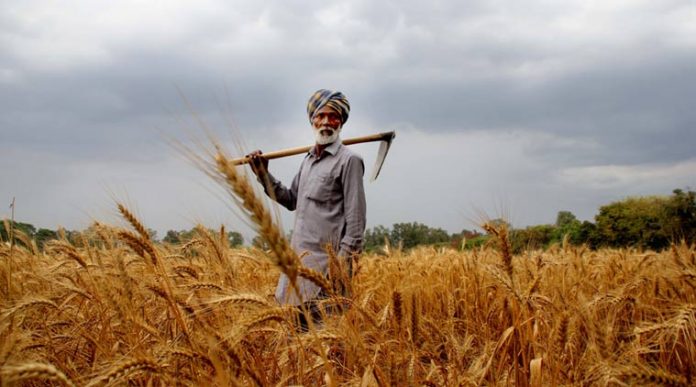This article is written by Bhumika Dandona from School of Law, Sushant University, Gurgaon. In this article, she deals with all the aspects of Minimum Support Price and steps that need to be taken in view of its current status.
Table of Contents
Introduction
Farmers are the cornerstone of every country. Our survival depends on the crops which they grow and provide us. They work day and night tirelessly just so that we don’t go empty stomach to bed. It is not only that, but the work they do ensures their survival as well. So farmers are significant indeed, more specifically for the Indian economy, for our economy is mostly agriculture-based. It is why it becomes necessary to provide them with all the possible support. The Central Government has launched several initiatives and measures overtime to do so. Farmers nowadays enjoy so many incentives extended by the government. One of such incentives is the Minimum Support Price.
What is MSP?
The Minimum Support Price or MSP refers to the amount at which the Central Government procures the harvest from farmers. It seeks to provide a safety cover to farmers, ensuring them protection when the prices come down. It also leads to an increase in the production of crops. There can be several reasons for a fall in prices, such as imbalances in the supply-demand chain, lack of market integration, changes in weather, etc.
Let’s understand it with the help of an example. Supposing wheat is abundant in a particular harvest season due to which there’s a sharp decrease in its price. Now farmers will be hesitant to grow wheat due to a lack of profit out of its sale. It will also cause an eventual shortage of the crop. It is where the government will then step in. The government will buy the leftover crop from farmers on the fixed MSP. So, it will not only extend financial support to farmers but will encourage them to grow more as well.
Thus, MSP forms an essential part of India’s agricultural policy.
Historical background
MSP first came on the scene during the Colonial rule, when the British introduced its rationing system. They then set up the Ministry of Food that later split into separate departments in the 1960s. It was a rough decade for the agricultural sector of India. The country was facing food scarcity owing to prevailing famine-like conditions and unfavourable import and export prices.
It prompted the adoption of various scientific methods such as effective pesticides, fertilizers, irrigation techniques, High Yielding Variety (HYV) seeds, etc. It is also why this period is known as that of the Green Revolution. However, the experts suggested that solely making use of these techniques would not be enough. There was a requirement for additional support.
The Central Government decided to buy the crops from farmers at a specific rate and sell them to consumers at affordable prices (Public Distribution System). It also aimed at securing stocks of crops. For doing so, there was a need for an appropriate pricing policy. The government then set up the Agricultural Prices Commission in the mid-1960s. The commission got a new name in 1985 – Commission on Agricultural Costs and Prices (CACP). The main work of the commission was to make recommendations concerning such policies. It is how the concept of MSP came into being. The policy of MSP developed in its entirety by 1975. Initially, MSP included just one crop that is, wheat. But over time, the government enlarged its ambit to include other crops as well.
The framework of MSP
The Central Government determines the MSP twice a year (that is, June and September), separately for the Kharif Crops and the Rabi crops. It takes into account the recommendations of the CACP while doing so.
Calculation of MSP
Variables
The Central Government set up the National Commission on Farmers in 2004. Also known as the Swaminathan Committee, it deals with all the problems faced by farmers. The committee developed the following variables for calculating the MSP:
A2 Variable
A2 consists of farmers’ expenditure on workers hired by them, seeds, pesticides, fuel irrigation and other items or services.
A2+FL Variable
A2+FL consists of actual costs and value allocated to the not paid family labour.
C2 Variable
C2 consists of A2+FL and income declined on the land and other fixed assets opened by farmers.
The CAPC suggests the use of the A2+FL variable for desirable returns.
Factors in consideration
The Commission considers the following factors for making the required recommendations:
- Production cost.
- Impact on cost of living.
- Impact on the general degree of price.
- Impact on subsidies.
- Impact on the cost structure of the industry.
- Alterations to prices of inputs.
- Price uniformity of input and output.
- International prices of export and import.
- Uniformity between paid prices and received prices.
- Status of demand and supply chain in the market.
- Uniformity in inter-crop prices.
- The course of market price.
Essential information
To prepare a report on the above-specified factors, the CACP collects the following essential information:
- Cultivation price per hectare and price structure of different regions in the country.
- Production price per quintal and price structure prevalent in every state in the country.
- The course of alterations to these cultivation prices and production prices.
- Input prices and related alterations.
- Prices in markets and changes to the same.
- Variables at the macroeconomic level.
- Costs incurred on marketing.
- Expenses incurred in the processing of agricultural commodities.
- Particulars of the supply chain, domestically and overseas.
- Details of the demand chain.
- Prices of products sold by farmers and alterations in it.
- Prices of commodities derived from agricultural products.
Entities and associations
Mentioned below are the entities and associations that provide such information to the CACP:
- Social activists.
- Food Corporation of India.
- Leaders of farmers’ groups and unions.
- Research establishments and Trade unions.
- National Agricultural Cooperative Marketing Federation of India.
Crops under MSP
Currently, MSP covers 23 crops which are as follows:
- Paddy and wheat.
- Jowar, bajra, ragi and maize.
- Gram pulse, urad dal, moong dal, arhar dal and lentils.
- Soybean, groundnut and mustard seeds.
- Sesamum and sunflower seeds.
- Niger seeds and safflower seeds.
- Virginia flue-cured (VFC) tobacco and Coconut (de-husked).
- Raw jute and cotton.
- Sugarcane and copra.
Legality of MSP
MSP has not yet acquired the force of law. It means, farmers cannot legally enforce it, neither the Central Government is bound to adhere to the same. The CACP did suggest the formulation of MSP into law, but the government rejected it.
In fact, it is the very reason for the ongoing dispute in relation to the Farm Laws, 2020. Farmers fear the removal of MSP due to no mention of it in any of the farm acts passed by the Parliament. They have been protesting against the laws since November 2020. Till now, no conclusion has been reached.
Merits of MSP
- MSP is an encouragement to farmers to produce the crop which is in shortage. It helps reach the minimum domestic consumption requirement.
- MSP leads to an increase in farmers’ income, allowing them to invest in essential products and services such as fertilizers, irrigation machines, etc.
- Due to the risks of fluctuations in price, farmers face the inability to sell their products. Purchase by the government proves to be of great help.
- MSP acts as a haven against bad weather conditions which can lead to the destruction of the crops produced.
Drawbacks of MSP
- The Central Government decides upon the MSP right before its announcement at the start of the sowing season. By then, the farmers already begin growing the crops. MSP does not benefit as much because of this reason. It has a limited impact on the whole production pattern.
- State governments do not have enough financial sources to buy crops from farmers.
- Many of the farmers are still not aware of the policy of the MSP. Only a minimum number of them, estimated to be only 6% are able to avail the benefits.
- Wheat and rice are the most commonly cultivated crops out of all. Others often get left out from the scope of MSP by farmers. Here, it goes in vain.
- MSP remains fixed throughout the country, based on the All-India-Average mechanism. It can be problematic for farmers because market prices and cultivation prices vary across the states.
- MSP has caused international trade distortion. Countries signatory to the World Trade Organisation or WTO often subject MSP to criticism. Nations like Australia, the United States of America and the European Union claim that India violates the ten percent norm for subsidy on-farm production.
- The crop procurement system set up by the government is highly inefficient.
- Increased MSP pressurizes the finances of the governments which leads to an increased subsidy burden.
Steps that could be taken
Keeping in view the disadvantages that MSP incorporates, the below-mentioned steps may be of use to take the policy to its full potential:
Awareness campaigns
As mentioned earlier, many farmers in the country do not know about the concept of MSP. The Central Government should organize awareness campaigns in agricultural regions and other rural areas to educate the farmers about its benefits. It will make sure that the maximum number of them avail MSP, which would improve their lifestyle and the sector’s situation. The government may collaborate with state governments and agricultural experts in this respect.
Crop diversification
It is essential to make farmers understand the importance of crop diversification. Limiting the production to just a few crops can cause a shortage of high nutritional value products. Again, the government should conduct awareness programs for the same.
Legal status
Conferring legal status upon MSP would be a huge sigh of relief for farmers. It will not only necessitate its enforcement. But it will also ensure other things such as a timely receipt of payment, less tiring trade process etc. Further, a legal force will reduce farmers’ exploitation at the hands of some traders who buy their crops at lower prices.
Better coordination with states
State governments often face problems in granting MSP to farmers for various reasons such as lack of information on the policy, limited funds, etc. The Central Government must communicate with state governments regarding all these matters and come to a relevant solution. It will lead to better implementation of MSP at the state level.
Improvement in procurement facilities
The current procurement process does not provide satisfaction to farmers. The government should make the procurement of crops a smooth process by improving the currently available facilities. Setting up more warehouses and employing maintenance services near farmings regions will lead to decreased food wastage. Appointing an efficient transportation system will fasten the supply of produce. All in all, it will ease the troubles of farmers.
Flexible price across different states
Since the Central Government fixes the MSP at a specific rate, it creates non-uniformity in terms of benefits that farmers acquire. Market prices and cultivation costs are different in every state. Being flexible in deciding MSP will benefit farmers of every state. The government should hold consultations with respective state governments and discuss the problem in question.
Conclusion
The Minimum Support Price is an integral part of the agricultural policy of India. It shields the farmers against unstable market prices and motivates them to cultivate more crops. It also safeguards against bad weather conditions. Crops covered under MSP range from wheat, bajra, ragi to sunflower seeds, raw cotton, sugarcane, etc.
But like anything, MSP comes with its disadvantages as well. No legal obligation, its rigid nature and lack of adequate continuity overshadow its benefits to a great extent. It’s time that the Central Government takes the necessary measures to enhance the policy. Because change is the only constant, the government should keep MSP up to date with the latest agricultural trends. Conducting awareness activities, sessions at the state level, making improvements in existing procurement facilities, etc. are some of the measures it may bring into effect.
References
- https://vikaspedia.in/agriculture/market-information/minimum-support-price
- https://neostencil.com/minimum-support-price
- https://www.jagranjosh.com/current-affairs/msp-for-crops-what-is-msp-how-is-msp-calculated-know-15times-formula-1607077300-1
- https://niti.gov.in/writereaddata/files/writereaddata/files/document_publication/MSP-report.pdf
LawSikho has created a telegram group for exchanging legal knowledge, referrals and various opportunities. You can click on this link and join:
 Serato DJ Crack 2025Serato DJ PRO Crack
Serato DJ Crack 2025Serato DJ PRO Crack










 Allow notifications
Allow notifications



